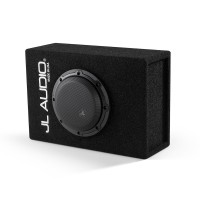Subwoofer JL Audio 8W3v3-4
8", 250 W RMS, 83.2 dB (1W/1m), 4 Ω
More about the product
More about the product
We will help you with your purchase
- Use our consulting room
- You can return the goods to us within 14 days
- Try the product at our store
Subwoofer JL Audio 8W3v3-4
JL Audio's W3v3 Series Subwoofers offer phenomenal sound quality at mid-range power levels without requiring bulky enclosures. This latest generation W3 benefits from a host of advanced technologies originally developed for JL Audio's flagship W7. The optimized long linear movement capability minimizes distortion and increases performance, while several patented technologies ensure high quality and reliability of the subwoofer. These advancements make the v3 the best sounding and most reliable W3 to date. The mineral-filled polypropylene diaphragm with the JL Audio logo provides a simple and elegant look. A removable and customizable decorative ring around the subwoofer allows for the installation of a protective grid, which can be purchased with subwoofers. The W3v3 is manufactured to strict quality standards in the Miramar, Florida factory with global components and is offered in five sizes, from 6.5" to 13.5". If you need an eight-inch subwoofer that enables high-quality bass in extremely small enclosures, the 8W3v3 will do just that and surprise you with its performance and precision. It uses the same technology as its larger diameter brothers to achieve an incredible 10mm of controlled, unidirectional, linear deflection. The 8W3v3-4 works best with amplifiers rated from 75 to 250W RMS and is optimized for operation in small 8.5L sealed enclosures. You can also install the subwoofer in a bass reflex enclosure with a volume of 9.9 l. A great choice for installation focused on sound quality and for cars where there is no space for a large enclosure.The main features of the JL Audio 8W3v3-4 subwoofer
- 8" subwoofer with a power of 250 W RMS and a coil with an impedance of 4 Ω.
- FCAM™ technology for better deflection control and dynamic voice coil alignment.
- Subwoofer motor optimized according to the patented DMA system.
- Patented Elevated Frame Cooling design for improved performance handling.
- The VRC® system improves the stiffness and stability of the diaphragm, spider and voice coil connection.
- Removable decorative strip for design adaptation of the installation.
- Optimized for small volume enclosures.
- Solid polypropylene membrane filled with minerals.
- Optional design grille to protect the subwoofer (not included).
- Manufactured using state-of-the-art technology at the JL Audio factory in Florida, USA.
About the JL Audio brand
JL Audio is an American manufacturer of consumer audio equipment that specializes in home, vehicle and boat sound systems. It is one of the main pioneers of vehicle sound systems and is undoubtedly best known for its high-end subwoofers. The company was founded in 1975 and is therefore one of the oldest manufacturers in this field. The original focus was on home sound systems, but already at the turn of the seventies and eighties, they also started to deal with the car audio segment, the popularity of which grew rapidly at the time. During their rich history, JL Audio produced a lot of completely unique and patented subwoofers that had almost no competition at the time. And it is similar even now. Subwoofers from this manufacturer amaze with their performance and at the same time absolutely top sound quality, unique patents and excellent workmanship. In particular, the top W6 and W7 series have long been among the most interesting products on the market today. However, the revolutionary flat subwoofers of the TW1 and TW3 series, as well as the perfectly tuned subwoofer enclosures, will also impress. You can expect the same quality from the amplifiers, and it's also worth noting the high-end products designed for integration into factory audio systems. In short, you can't go wrong with JL Audio products and you can always rely on their high quality and uniqueness.
| Catalog number | 8W3V3-4 |
| Brand | JL Audio |
| Links | Official web presentation (English) |
| RMS powerThe RMS power of the subwoofer is the constant power of continuous use of the subwoofer. If the power is exceeded for a longer period of time, irreversible damage may occur, or to burn out the voice coil of the subwoofer. | 250 W |
| Sensitivity (SPL 1W/1m)Subwoofer sensitivity or efficiency. The sensitivity of the subwoofer is given in decibels (dB) and, in simple terms, means that the higher the value, the lower the demands on the power of the amplifier. This is a de facto rating of how a subwoofer converts watts to sound. Sensitivity ratings are in noise level measured at 1 meter from the subwoofer using 1 W (watt of power) or using 2.83 volts at the source at 1 meter. A higher decibel level means the subwoofer is louder with less power. For every 3 dB increase in sensitivity, the subwoofer requires half the power to reproduce the same volume. For example, if an 88 dB subwoofer needs 300 watts to produce a certain volume, then a 91 dB subwoofer needs only 150 watts to reach the same efficiency. | 83.24 dB |
| ImpedanceImpedance - measurement of electrical resistance. When buying a subwoofer, it is very important that everyone make sure that the impedance matches the amplifier that you are connecting to it. For subwoofers with a double voice coil, we recommend following the information in the advice center! Example: A 2 Ohm subwoofer cannot be connected to an amplifier that is only stable up to 4 Ohms. A 4 Ohm subwoofer can easily be used on an amplifier that is stable up to 2 Ohms. Connecting a 4 Ohm subwoofer to an amplifier that is stable up to 4 Ohms also without problems. The most common subwoofer impedance is 4 Ohm. | 4 Ω |
| Subwoofer diameterThe diameter of the subwoofer is indicated on the screw holes. The overall outer diameter of the subwoofer is usually 1-2 cm wider, depending on the size category of the subwoofer. For a 30 cm subwoofer, the outer diameter incl. protective rubber 31.8 cm and in the 25 cm subwoofer it is 26.5 cm incl. protective rubbers. | 200mm (8") |
| Subwoofer mounting depthThe mounting depth of the subwoofer is measured from the bottom edge of the magnet to the bottom edge of the subwoofer's metal or cast basket. | 118 mm |
| Recommended enclosure volumeThe closed enclosure is characterized by a simple construction. Closed enclosures are usually smaller than bass-reflex enclosures, and a special damping fleece is used for their damping. A closed baffle has the advantage of preventing an acoustic short between the front and back radiation of the subwoofer diaphragm. The disadvantage is that the closed enclosure raises the natural resonance frequency of the used subwoofer and thereby also increases the lower limit frequency. This is because the back side of the diaphragm is forced to compress and dilute the air inside the enclosure when the subwoofer is radiating in a closed enclosure. This adds to the inherent stiffness of the subwoofer's oscillation system the stiffness of the air in the closed enclosure. This causes an increase in the stiffness of the oscillating system and thus an increase in the resonant frequency of the entire system: subwoofer -> loudspeaker. The increase in resonant frequency for a given subwoofer is greater, the smaller the volume of air in the closed enclosure. The relatively small volume of air in the closed enclosure acts on the subwoofer as an acoustic spring when radiating the back side of the membrane into the enclosed enclosure. USE: Mainly for quality bass listening in the entire band with an emphasis on detail and accurate reproduction in the lower band. Pros and cons: + pure reproduction + small closets + easier tuning - low level of efficiency in deep bass - loudness only at the cost of enormous deflection of the membrane - a significant acoustic pressure cannot be expected | 8.5 l |
| Recommended bass reflex speaker volumeA bass reflex enclosure is designed in the same way as a closed enclosure, but it also has a so-called bass reflex mouthpiece, or "bass reflex" or slot. Needle foam is used to dampen bass reflex enclosures. USE: The ideal use is in cases where the listener wants to achieve a high volume and a good sound pressure level. It is the best compromise between sound quality and performance and is also the most commonly used Pros and cons: + good efficiency in deep bass + a small deflection of the membrane is enough for a large volume - reproduction less accurate than with closed enclosures | 9.9 l |
| Bass reflex sizeThe mouthpiece, or bass reflex, is used in the construction of bass reflex enclosures. The length and diameter of the bass reflex are very important parameters and it is necessary to follow what the specific subwoofer manufacturer recommends. We strongly recommend purchasing only branded and high-quality bass reflexes with a rounding at the end of the bass reflex. If the bass reflex is terminated by a straight tube, the result is the so-called "farting" of the subwoofer, when the air blowing out of the bass reflex hits the sharp end of the bass reflex. | 51 x 457 mm |
| Fs - resonant frequencyFs - is the lower resonant frequency. This parameter is the de facto free air resonant frequency of the subwoofer. Simply put, it is the point at which the weight of the subwoofer's moving parts equals the force of the subwoofer's suspension while it is in motion. If you've ever seen a piece of string start to hum uncontrollably in the wind, you've seen the effect of reaching a resonant frequency. The weight of the moving parts and the stiffness of the suspension (surround and spider) are key elements that affect the resonant frequency. As a general rule, a lower Fs indicates a subwoofer that would be better at reproducing low frequencies than a subwoofer with a higher Fs. However, this is not always the case, as other important parameters of the subwoofer also enter the resulting sound. | 35.14 Hz |
| Vas - equivalent volume of airVas - represents the volume of air that, when compressed per cubic meter, acts with the same force as compliance (CMS), suspension in a certain subwoofer. Vas is one of the most complicated parameters to measure, as changes in air pressure are affected by conditions of relative humidity and temperature. Another way to describe what VAS is: try using a subwoofer and find a baffle that is the right size to return the air with the same stiffness to the same resonance. The size of this box is equal to you. There are, of course, other parameters, but they are not so necessary for the exact calculation of the enclosure. Resonance frequency and Q-parameter values are also important when building enclosures. | 15.29 l |
| Xmax + -Xmax - the maximum deflection of the subwoofer diaphragm in one direction – it is not a sum, or an abbreviation for the maximum linear deflection. The subwoofer output becomes non-linear as the voice coil begins to leave the magnetic gap. | 10 mm |
Product comments
Evaluation
ask us









































